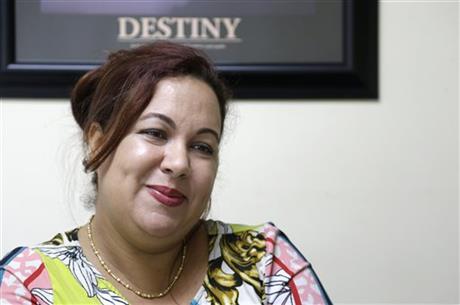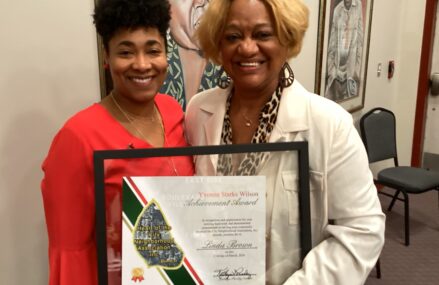
By CHRISTINE ARMARIO
In this Sept. 19, 2013 photo, Irka Ducasse Blanes, a recent Cuban immigrant, smiles during an interview at a tax preparation office where she works in Miami. Since 2002, the number of Cubans leaving has hovered around 30,000 annually, making the last 10 years the largest exodus since the start of the revolution. The influx of new arrivals is evident throughout Miami, the heart of Cuba’s exile population. In 2007, Blanes came to America when she was six months pregnant, bringing with her a 7-year-old daughter, followed soon after by her husband. The family wanted a better future for their children, and today Blanes does identify with the term “exile.” (AP Photo/Wilfredo Lee)
MIAMI (AP) — At a small store on Eighth Street near Miami’s Little Havana, Armando Perez paid $25 to activate his daughter’s cell phone in Cuba. Store owner Laura Benitez sat behind a glass window, typing in the phone numbers for Perez and others calling Cuba.
“I call my daughter every week, even if it’s just for her to say, ‘Papi, I love you,'” said Perez, a thin man who left the island on a boat in 2008.
Benitez, who fled with her parents shortly after the 1959 Cuban Revolution, doesn’t have family in Cuba. Many of her clients, however, grew up under the communist system and immigrated in the last 10 years.
“They need to go back to Cuba to see their family,” Benitez said. “I don’t understand because my parents are here. Maybe if they were in Cuba I would go back.”
Some 46,662 Cubans left the island legally and permanently last year, the largest migration in a single year since 1994, according to figures from Cuba’s National Statistics Office. Since 2002, the number leaving has hovered around 30,000 annually, making the last 10 years the largest exodus since the start of the revolution. That’s in addition to an estimated 7,000 to 19,000 who leave Cuba illegally each year — some by boat and many with the U.S. as their final destination.
The influx of new arrivals is evident throughout Miami, the heart of Cuba’s exile population, from myriad shops offering cell phone services to street fliers about performances by artists who still live on the island.
Cubans arriving today grew up on the island after the revolution, and their relationship with their homeland is different than the wave of immigrants who arrived immediately after Fidel Castro took power. Their growing numbers are bringing those stark contrasts to the fore, leading to moments of friction between groups and putting into question what it means to be a Cuban “exile.”
The clashes surface in a big way when older Cuban Americans protest outside concerts and sporting events featuring Cuban musicians and athletes who draw throngs of fans who grew up listening and watching them. The rifts are also apparent in small exchanges at shops like Benitez’s.
Benitez’s mother was a Jehovah’s Witness and spent three years in jail for preaching before fleeing on one of the Freedom Flights, the twice daily flights that carried more than 265,000 Cubans out of the island between 1965 and 1973.
“My mom said we were refugees,” Benitez recalled. “If she could have gone back, I don’t think she would have. How can we go back to a country that did not want us?”
By contrast, Cubans fleeing today rarely cite political persecution.
“In Cuba, I didn’t live so badly,” said Perez, a 63-year-old truck driver who walks around with a Bluetooth device in his ear. Perez came to America on a boat with 30 other people to reunite with his son, who had fled several years ago.
At the strip mall where Benitez’s store is located, tax accountant Irka Ducasse Blanes recalls how, when she lived in Cuba, she did not understand why Cuban Americans called themselves “exiles.”
Blanes, 40, worked in finance at the Hotel Habana Riviera in Cuba. She lived relatively well, traveling internationally for work twice a year. In 2007, she came to America when she was six months pregnant, bringing with her a 7-year-old daughter. Her husband soon followed.
The family wanted a better future for their children, and today Blanes does identify with the term “exile.”
“The word ‘exile,’ I think, means you’re in a place where you can’t go whenever you want to your birth country,” she said.
Many Cuban immigrants today do return, however, some quite frequently. According to the Cuban government, about 500,000 U.S. visitors travel to the island every year, the majority Cuban Americans.
Their reasons for immigrating — primarily economic and not political persecution— combined with frequent visits home, raise questions about whether they can be accurately called “refugees.” U.S. Citizenship and Immigration Services define refugees as “generally people outside of their country who are unable or unwilling to return home because they fear serious harm.”
Some immigration activists and politicians have said it’s time to revisit policies that offer generous privileges to Cubans immigrating to the U.S., like the Cuban Adjustment Act, by which Cubans who reach U.S. soil are allowed to stay and are fast-tracked toward residency.
“I don’t criticize anyone who wants to go visit their mom or dad or their dying brother or sister in Cuba,” U.S. Sen. Marco Rubio, a prominent Florida Republican born in Miami to Cuban parents, told the American Society of News Editors earlier this year. “But I am telling you it gets very difficult to justify someone’s status as an exile and refugee when a year and a half after they get here they are flying back to that country over and over again.”
Emilio Morales, a market researcher in Cuba before immigrating to the U.S. in 2007, characterized the relationship between revolution era exiles and today’s arrivals as “bad.” He said recent arrivals are not interested in politics, and don’t feel that something was taken from them.
Cubans have come to American in three general waves: Post-revolution immigrants who faced persecution in Cuba, those coming in the 1980s, when thousands were permitted to leave by boat, chiefly in opposition to the communist government’s policies, and those who have come since 1994, largely for economic reasons after the collapse of the Soviet Union.
All seven Cuban Americans in Congress come from families that immigrated shortly after 1959, and the majority support hard-line policies toward the island, in line with the views of the generation they represent.
The older generations of Cuban exiles “don’t have anything in common with us, culturally, politically, nothing,” said Morales, 44, who now runs his own consulting business in Miami.
Rafael Gonzalo, 69, who came to the U.S. in 1959 when he was 15, said Cubans who came decades ago rarely interact with recent arrivals. Cuban Americans today are immigrants, not exiles, Gonzalo said, and their differences range from how they talk and dress to their work ethic.
“Those who come don’t like to work a lot,” he said. “You have to look for the root of the problem. The problem is, in Cuba they don’t work.”
Instead, he said, they survive by “resolver,” which in Cuba means having to invent or barter to make ends meet.
Blanes cringes when she hears comments like that. She spent long hours studying at night while caring for two young daughters to re-establish her career here. Many of the unemployed have struggled to find jobs, but do want to work, she said.
Back at the store, Benitez empathizes with her clients, but feels compelled to remind them of the freedoms they enjoy here.
Although he doesn’t mention it, Perez was once arrested for illegally selling meat he butchered in Cuba, she said. Still, she recognizes that persecution was not Perez’s main motivation in leaving.
“Hunger is hunger,” Benitez said. “Necessity is necessity. The freedom is somewhere in there, but your stomach is first.”
_


